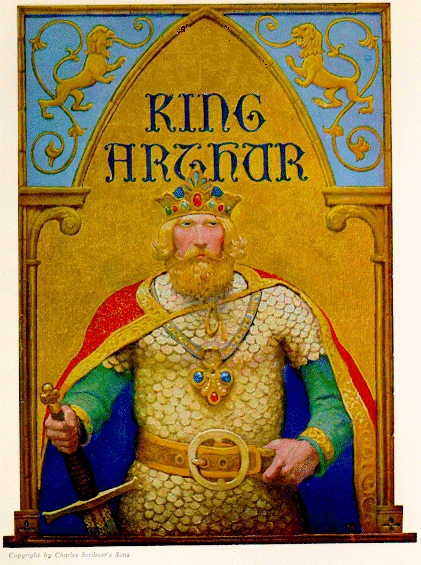

Although King Arthur is one of the most well-known figures in the world, his true identity remains a mystery. Attempts to identify the historical Arthur have been unsuccessful, since he is largely a product of fiction. Most historians, though, agree that the real Arthur was probably a battle leader of the Britons against the Anglo-Saxons in the sixthth century. In literature, King Arthur's character is unique and ever changing, taking on a different face in every work. There is never a clearly definitive picture that identifies Arthur's character. It is therefore necessary to look at a few different sources to get better insight into the character of Arthur, the once and future king.
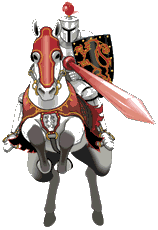 Arthurian
literature can be divided into two basic categories, pseudo-histories and
romances. The main difference between the two is that pseudo-histories
such as Wace and much of the Celtic work, for example, Geoffrey
of Monmouth show Arthur as a strong, central character, making him
the dominant figure in the story. He is the one who goes on quests and
battles, gaining respect and glory for his court. In romances, however,
Arthur is most often overshadowed by his knights, staying mainly in the
background as the source and the inspiration behind their great chivalric
deeds.
Arthurian
literature can be divided into two basic categories, pseudo-histories and
romances. The main difference between the two is that pseudo-histories
such as Wace and much of the Celtic work, for example, Geoffrey
of Monmouth show Arthur as a strong, central character, making him
the dominant figure in the story. He is the one who goes on quests and
battles, gaining respect and glory for his court. In romances, however,
Arthur is most often overshadowed by his knights, staying mainly in the
background as the source and the inspiration behind their great chivalric
deeds.
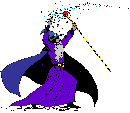 The
first written chronicle of Arthur's adventures comes from Nennius,
a monk from North Wales. In his ninth century writing, Nennius tells of
Arthur's twelve victories over the Saxons but describes him only as a dux
bellorum "a leader of battles" and not a king. It was Geoffrey of Monmouth
who first proclaimed Arthur as king in his twelfth century Historia
Regum Britanniae, which became the foundation for all Arthurian literature
to follow. This work contains all of the most famous Arthurian elements
such as the Sword in the Stone, the magical Merlin, and the love affair
between Lancelot and Guinevere. But it was Wace, who using Geoffrey's work
was first to mention Arthur's Round Table and amplify the belief in Arthur's
return from Avilon, or the Isle of Avalon.
The
first written chronicle of Arthur's adventures comes from Nennius,
a monk from North Wales. In his ninth century writing, Nennius tells of
Arthur's twelve victories over the Saxons but describes him only as a dux
bellorum "a leader of battles" and not a king. It was Geoffrey of Monmouth
who first proclaimed Arthur as king in his twelfth century Historia
Regum Britanniae, which became the foundation for all Arthurian literature
to follow. This work contains all of the most famous Arthurian elements
such as the Sword in the Stone, the magical Merlin, and the love affair
between Lancelot and Guinevere. But it was Wace, who using Geoffrey's work
was first to mention Arthur's Round Table and amplify the belief in Arthur's
return from Avilon, or the Isle of Avalon.
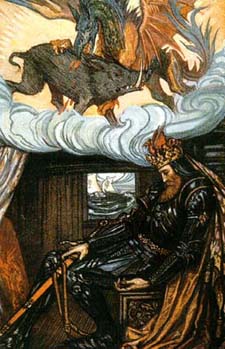 King
Arthur's character has many faces. He is shown to be kind, wise and
generous on one hand, yet at the same time, he can be seen as a weak king
who is stubborn, childish, and unable to make wise decisions for himself
or for the good of the court. He is described by Nennius as a powerful
warrior, who is able to personally slay 960 men in one charge. Wace shows
him possessing leadership qualities as he establishes the Round Table to
ensure that justice and peace prevail. In Celtic legends, Arthur is a supernatural
hero who battles giants, monsters, and witches. He kills the Demon Cat
of Losanne and hunts the boar Twrch Truyth driving him into the sea.
(Camelot
and Arthurian Legend: Arthur online 4/27/98)
King
Arthur's character has many faces. He is shown to be kind, wise and
generous on one hand, yet at the same time, he can be seen as a weak king
who is stubborn, childish, and unable to make wise decisions for himself
or for the good of the court. He is described by Nennius as a powerful
warrior, who is able to personally slay 960 men in one charge. Wace shows
him possessing leadership qualities as he establishes the Round Table to
ensure that justice and peace prevail. In Celtic legends, Arthur is a supernatural
hero who battles giants, monsters, and witches. He kills the Demon Cat
of Losanne and hunts the boar Twrch Truyth driving him into the sea.
(Camelot
and Arthurian Legend: Arthur online 4/27/98)
 Some
literary work depicts Arthur as an ideal Christian hero and as among God's
elect. Young Arthur is able to withdraw the sword from the stone because
he has been chosen by God to be the next king. Officers in the Roman army
carried shields bearing portraits of their emperors. Geoffrey describes
Arthur having a shield with the likeness of the Virgin Mary; this is a
perfect image for a Christian hero who is primarily under the authority
of God.
Some
literary work depicts Arthur as an ideal Christian hero and as among God's
elect. Young Arthur is able to withdraw the sword from the stone because
he has been chosen by God to be the next king. Officers in the Roman army
carried shields bearing portraits of their emperors. Geoffrey describes
Arthur having a shield with the likeness of the Virgin Mary; this is a
perfect image for a Christian hero who is primarily under the authority
of God.
Yet there also
exists a different Arthur. In Chretien de Troyes's Erec et Enide,
knowing that it will bring harm to the court, Arthur insists on hunting
the white stag. Lik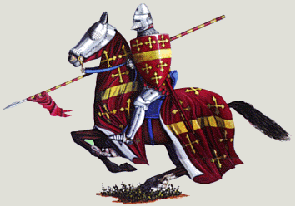 ewise
in "The Wedding of Sir Gawain and Dame Ragnell," Arthur's is shown
as king who is far from heroic; on the contrary, he is shown as weak and
helpless. He is unable to defend himself when confronted with a challenge
by Gromer Somer Jour and requires Sir Gawain's help. In Sir Gawain and
the Green Knight, Arthur acts like a child, unable to sit still or
eat until he has seen something great. And even though he rushes to accept
the Green Knight's challenge, showing his courage, Arthur is later second-guessed
as members of the court question his actions of placing his best knight,
Sir Gawain in danger by saying, "Who would credit that a king could be
counseled so, and caught in a cavil in a Christmas game?" (Norton
p. 216) In Chretien's Yvain, Arthur can't stay awake after a feast, causing
confusion in the court and further demonstrating his childlike characteristics.
ewise
in "The Wedding of Sir Gawain and Dame Ragnell," Arthur's is shown
as king who is far from heroic; on the contrary, he is shown as weak and
helpless. He is unable to defend himself when confronted with a challenge
by Gromer Somer Jour and requires Sir Gawain's help. In Sir Gawain and
the Green Knight, Arthur acts like a child, unable to sit still or
eat until he has seen something great. And even though he rushes to accept
the Green Knight's challenge, showing his courage, Arthur is later second-guessed
as members of the court question his actions of placing his best knight,
Sir Gawain in danger by saying, "Who would credit that a king could be
counseled so, and caught in a cavil in a Christmas game?" (Norton
p. 216) In Chretien's Yvain, Arthur can't stay awake after a feast, causing
confusion in the court and further demonstrating his childlike characteristics.
In Sir Thomas
Malory's Le Morte Darthur, Merlin, a magician who is Arthur's advisor,
is responsible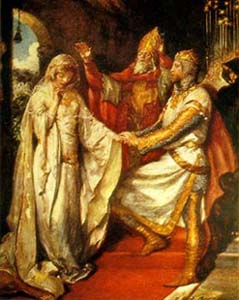 for
his rise to glory. Merlin's presence is key in Arthur's every step, even
his birth. Arthur seems lost without Merlin's advice, and the decisions
he makes against Merlin's wishes seem to backfire. Furthermore, in this
tale, Arthur seems to be responsible for his own downfall. By having an
affair with Lot's wife, who turns out to be his half-sister, he fulfills
Merlin's prophecy of his downfall as Mordred, who will later kill Arthur,
is produced by this incestuous affair. Also when Arthur, saddened
by the death of Gareth and Gaheris, who are killed by Lancelot as he rescues
Guinevere, states: "My heart was never so heavy as it is now. And much
more I am sorrier for my good knights' loss than for the loss of my fair
queen; for queens I might have enough, but such a fellowship of good knights
shall never be together in no company." (Norton p. 353), it can
be seen that Arthur values his knights more than his queen. This indifference
towards his wife may have led Guinevere into Lancelot's arms, causing a
rift between Arthur's knights and setting the stage for an irreversible
path towards the downfall of Camelot.
for
his rise to glory. Merlin's presence is key in Arthur's every step, even
his birth. Arthur seems lost without Merlin's advice, and the decisions
he makes against Merlin's wishes seem to backfire. Furthermore, in this
tale, Arthur seems to be responsible for his own downfall. By having an
affair with Lot's wife, who turns out to be his half-sister, he fulfills
Merlin's prophecy of his downfall as Mordred, who will later kill Arthur,
is produced by this incestuous affair. Also when Arthur, saddened
by the death of Gareth and Gaheris, who are killed by Lancelot as he rescues
Guinevere, states: "My heart was never so heavy as it is now. And much
more I am sorrier for my good knights' loss than for the loss of my fair
queen; for queens I might have enough, but such a fellowship of good knights
shall never be together in no company." (Norton p. 353), it can
be seen that Arthur values his knights more than his queen. This indifference
towards his wife may have led Guinevere into Lancelot's arms, causing a
rift between Arthur's knights and setting the stage for an irreversible
path towards the downfall of Camelot.
Two Arthurs are
present in Arthurian literature. One is an epic hero who is flawless and
can do no wrong. He is the ideal, who is the symbol of the values of the
Round Table. The second Arthur is more human. He is depicted as a two-dimensional
character, with faults and imperfections. This Arthur is more popular,
as the reader is better able to relate to an imperfect king than to an
untouchable warrior. This Arthur feels fears, jealousy, and has doubts.
However despite these flaws he always retains his prestige. Arthur continues
to personify the ideal of the chivalric code and remains a glorious, beloved,
and respected king whose authority stays intact despite his weaknesses.
These qualities make King Arthur a true legend, which continues to fascinate
and intrigue audiences throughout the generations.